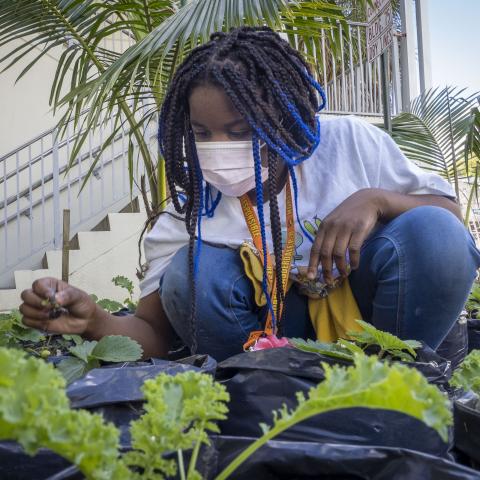Urban Agriculture in Mankato

Submitted by Rashaan Jeffery, Public Affairs Specialist
ST. PAUL, MINN, JULY 20, 2022 - The Living Earth Center in Mankato reached out to the National Recourses Conservation Service (NRCS) seeking technical assistance for a plot of land they are currently using for a community farm. The community farm started in 2021 with a partnership with Blue Earth County. Living Earth Center manages an acre of county land adjacent to the Red Jacket Trail across from Weagel Park in Mankato.
Living Earth Center is part of the Region Nine grant agreement, which provides federal funding to help with economic recovery. The U.S. Economic Development Administration awarded $3.6 million through the CARES Act Recovery Assistance grants to the eight Regional Economic Development districts in Minnesota. The funds are to be used to update economic development plans and for other resources to help the regions recover from the pandemic.
Laura Peterson, Living Earth Center Executive Director, reached out to NRCS to get help in determining the soil health and makeup of the soil on the property next to Red Jacket Trail. She also wanted suggestions on how improve the community farm. Peterson said, “I know that NRCS can provide the technical expertise that we don’t have.”
In late June, the local NRCS field office provided on-site technical assistance. Mankato District Conservationist, Ciara Ahrens said, “the site visit was used to get ideas on how to make this community project thrive and to see if there were any financial Farm Bill Programs applicable to them.”
The NRCS staff used soil boring to determine the water table, check for deep compaction layers and test for any containments that would need further investigation. Ahrens said, “It was very obvious that this soil profile has been manipulated so we want to conduct a thorough survey of the soil.” The staff discussed soil health practices and shared ideas about a compost facility, nutrient management, cover cropping, and hoop houses. Additionally, the engineering staff conducted a full survey to determine if the site had any drainage systems options.
Peterson said, “we can use what we are doing with the NRCS as an education point -- if you have some of these challenges, what are the regenerative solutions that are more cost effective and have a positive impact. We can look at integrated solutions that are healthy for the environment and healthy for the community.”
Results of the additional soil analysis will help NRCS and the Living Earth Center determine the best path forward for additional technical assistance and the potential for financial Farm Bill assistance. Ahrens said,” Aside from our nine-step planning process, the very first step is to create a relationship and trust with whomever we are working. Doing site visits such as these allows NRCS to build stronger bridges with communities and get more conservation on the ground.”
The vision for the community farm is to provide land for emerging farmers to grow local food, participate in the community economy and reconnect with the land. Peterson said, “a big goal is to work with NRCS and other organizations in the area so we can access a much larger space for people who really want to farm, but don’t have the capital to invest in their own land and can emerge into it from a gradual process.”
Urban agriculture is trending within the metropolitan food landscape right now. Many urban sites will be locations that had numerous land uses in the past and the history of the land and health of the soil may not always be clear until further investigation occurs. Ahrens said, “I think this project is a future snapshot of the many challenges urban ag will face.”
Urban agriculture is an opportunity to bring the city and the country lifestyle together with the common goal of feeding the world and one community at a time.


